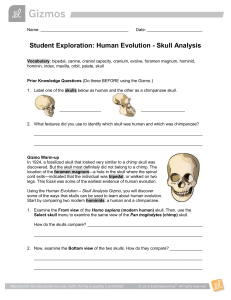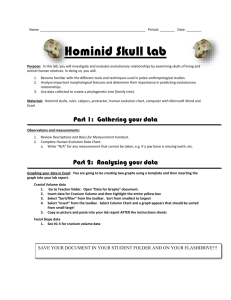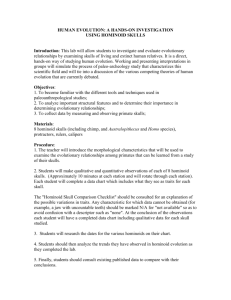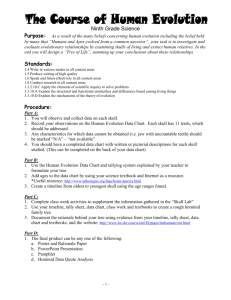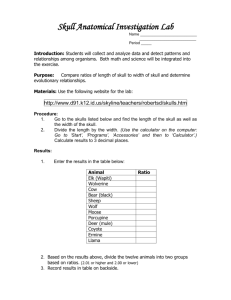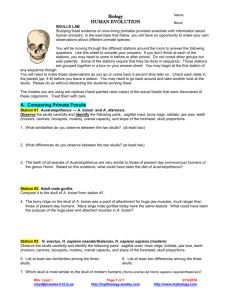Homo skulls activity
advertisement
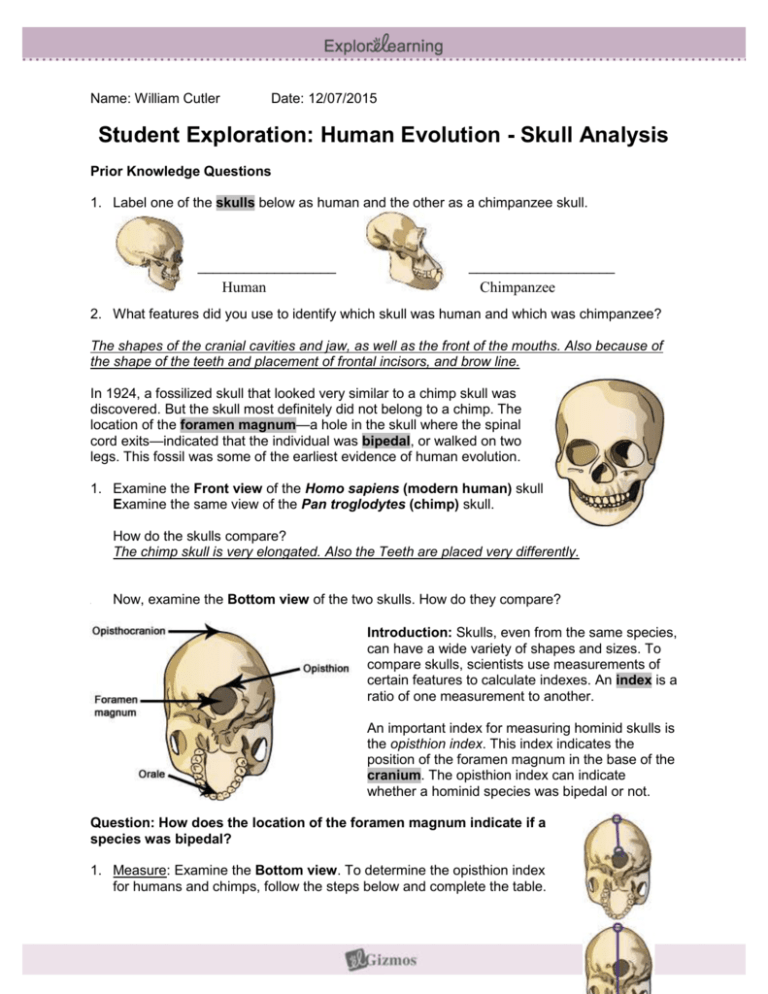
Name: William Cutler Date: 12/07/2015 Student Exploration: Human Evolution - Skull Analysis Prior Knowledge Questions 1. Label one of the skulls below as human and the other as a chimpanzee skull. __________________ Human ___________________ Chimpanzee 2. What features did you use to identify which skull was human and which was chimpanzee? The shapes of the cranial cavities and jaw, as well as the front of the mouths. Also because of the shape of the teeth and placement of frontal incisors, and brow line. In 1924, a fossilized skull that looked very similar to a chimp skull was discovered. But the skull most definitely did not belong to a chimp. The location of the foramen magnum—a hole in the skull where the spinal cord exits—indicated that the individual was bipedal, or walked on two legs. This fossil was some of the earliest evidence of human evolution. 1. Examine the Front view of the Homo sapiens (modern human) skull. Then, use the Examine the same view of the Pan troglodytes (chimp) skull. How do the skulls compare? The chimp skull is very elongated. Also the Teeth are placed very differently. 2. Now, examine the Bottom view of the two skulls. How do they compare? Introduction: Skulls, even from the same species, can have a wide variety of shapes and sizes. To compare skulls, scientists use measurements of certain features to calculate indexes. An index is a ratio of one measurement to another. An important index for measuring hominid skulls is the opisthion index. This index indicates the position of the foramen magnum in the base of the cranium. The opisthion index can indicate whether a hominid species was bipedal or not. Question: How does the location of the foramen magnum indicate if a species was bipedal? 1. Measure: Examine the Bottom view. To determine the opisthion index for humans and chimps, follow the steps below and complete the table. Measure the distance from the opisthocranion to the opisthion, as shown at top right. Record the opisthocranion-opisthion distance in the table below. Measure from the opisthocranion to the orale, as shown at bottom right. Record the opisthocranion-orale distance in the table. To calculate the opisthion index, divide your first measurement by your second measurement. Multiply this number by 100. Species Opisthocranionopisthion distance (cm) Opisthocranionorale distance (cm) Opisthion index Homo sapiens 4 cm 15.5 cm 25.806452 cm Pan troglodytes 2.5 cm 20.5 cm 12.317 cm 2. Analyze: The opisthion index is an indicator of where the foramen magnum is situated. The greater the opisthion index, the closer the foramen magnum is to the center of the cranium. This position is usually found in species that stand upright. A low value for the opisthion index occurs when the foramen magnum is situated in the rear of the cranium. This may indicate that the species walked on its knuckles or on four legs. Using the index values you calculated, what can you conclude about humans and chimps? That humans stand very upright in comparison with Chimps. Although it is a distance of only 1.5 cm it makes a lot of difference 3. Gather data: Humans, chimpanzees, and the other great apes are hominids. Hominids evolved from a common ancestor that lived about 13 million years ago. Hominins are hominids that belong to the lineage that led to humans. Measure the opisthion index of the other hominids available in the Gizmo. Species Opisthocranionopisthion distance (cm) Opisthocranionorale distance (cm) Opisthion index A. afarensis 3.9cm 16.6cm 22.9cm A. africanus 3cm 17.3cm 17.3cm H. habilis 5.25cm 18.5cm 28.38cm H. erectus 4.5 cm 19.5 cm 23.07cm H. heidelbergensis 7cm 23.3cm 30.15cm 20.5 cm 26.0829 cm H. sapiens 5.5 cm neanderthalensis 4. Analyze: Hominins are characterized by bipedalism. A. Based on their opisthion indexes, which of the hominids are hominins? H. sapiens neanderthalensis, H. heidelbergensis, and H. habilis. B. Based on opisthion indexes, which hominin skulls are most similar to human skulls? H. sapiens neanderthalensis, H. heidelbergensis, and H. habilis. 5. Explain: Why do you think the foramen magnum is positioned near the rear of the cranium for knuckle-walking species and near the center of the cranium for bipedal species? Because of the angle at which their head must be in order to be able to see clearly when walking on all fours. Introduction: The brain is housed inside the cranium. The internal volume of the cranium is called the cranial capacity. The larger an organism’s cranial capacity is, the larger its brain tends to be. Question: How does the cranial capacity compare amongst hominids? 1. Measure: To estimate the cranial capacity of each skull measure the area of the part of the cranium that houses the brain. This part of the cranium is roughly behind the red line in the diagram at right. You can also use the three skull images below as a guide for measuring the rest of the skulls. After you measure the area of each cranium, multiply the result by 7. This will give you a very rough estimate of the species’ cranial capacity. Homo sapiens Pan troglodytes Australopithecus afarensis Species Area of cranium (cm2) Estimated cranial capacity (cm3) Pan troglodytes 42 294 A. afarensis 66 462 A. africanus 74 518 H. habilis 91 637 H. erectus 134 938 H. heidelbergensis 183 1281 H. sapiens neanderthalensis 208 1456 H. sapiens 190 1330 2. Analyze: Examine the estimated cranial capacities you calculated. A. Which species probably had the largest cranial capacities? H. erectus H. heidelbergensis H. sapiens neanderthalensis H. sapiens B. What do you think cranial capacity is a good indicator of? Brain size, nothing more. There are a lot of studies done on how brain size has nothing to do with intelligence. C. Did any hominids have a larger cranial capacity than humans? If so, which species? I’ll bet some do. You got me. 3. Draw conclusions: Compare the data you collected in activity A with the data you collected in this activity. Which evolved first in hominins: bipedalism or large brains? Explain. Larger Brains. The size of brain almost doubles twice along the evolutionary line. Plus the it starts to grow in much bigger leaps and much earlier than bipedalism.
